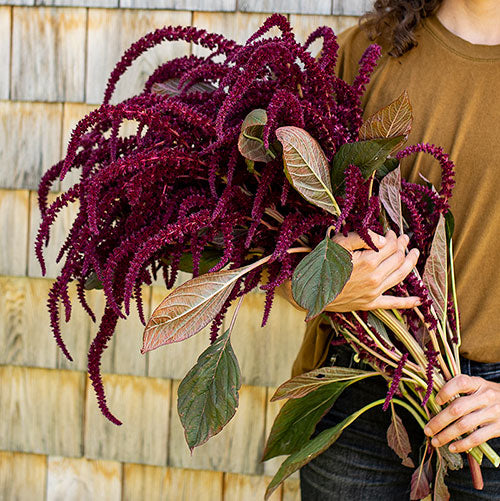Olive Seed Company
Amaranth 'Oeschberg'
Amaranth 'Oeschberg'
Couldn't load pickup availability
Oeschburg (Amaranthus caudatus)
Oeschburg amaranth offers a striking blend of deep eggplant-purple leaves and smoky flower spikes that smoulder beautifully among the rich reds and bright chartreuse greens of a late-summer border. This dramatic foliage adds a sophisticated, almost velvety texture to the garden, creating a rich tapestry of colour and form. Whether planted as a bold backdrop or mixed with sunflowers, dahlias, and zinnias, Oeschburg provides height, contrast, and garden intrigue from midsummer into fall.
More than just a beauty, Oeschburg is a practical choice as well. The tender young leaves can be harvested for fresh, nutritious salad greens, while the mature seeds, ripening in late summer, are both edible and a favorite food for local birds. This variety self-sows readily, returning year after year to grace the garden. For floral use, cut at peak bloom and hang stems upside down to dry, preserving their elegant shape and colour. Also known as Tassel Flower, Oeschburg blends bold garden beauty with edible and ecological value.
DETAILS:
QTY: 200
TYPE: Annual
SITE: Full Sun
DEPTH: BARELY COVER
GERMINATION: 7 - 10 days at 21 - 24°C
HEIGHT: 24" - 30” Support may be necessary.
MATURITY: 65 - 75 Days
SPACING: 12 - 15”
PINCH: Yes
HOW TO GROW:
Transplanting (recommended): Start seeds indoors 4–6 weeks before your average last frost date. Barely cover the seeds with a fine layer of soil or vermiculite, as they require light to germinate. To avoid displacing them, bottom water or mist gently. Harden off seedlings by growing them at night temperatures of – before transplanting outdoors after all danger of frost has passed.
Direct Seeding (alternative): Sow seeds outdoors after your last frost date. Sow seeds thinly and barely cover. Once seedlings have developed their first true leaves, thin them to a final spacing of 12–15" apart.
Pinching and Support: Pinching the tops of young plants will encourage a bushier habit and more blooms. Taller varieties may require staking or other support to prevent them from flopping over.
Soil Preference and Watering: Amaranthus thrives in full sun and tolerates a wide range of soil conditions, but prefers well-drained soil. It is a heat-loving and drought-tolerant plant once established, but will perform best with consistent moisture.
Fertilizing: Fertilizing is not typically necessary unless your soil is very poor. Over-fertilizing, especially with nitrogen, can lead to excessive foliage growth and fewer flowers.
Harvesting: For bouquets, harvest amaranthus when the flowers are about three-quarters of the way open and the stems are firm. For drying, harvest when the flowers are fully developed and the seeds are set. Hang bunches of stems upside down in a dark, well-ventilated area until completely dry.
Shipping & Returns
Shipping & Returns

-
Free Shipping
Free Shipping on all orders in Canada over $125.00

